Colleges
- American Athletic
- Atlantic Coast
- Big 12
- Big East
- Big Ten
- Colonial
- Conference USA
- Independents (FBS)
- Junior College
- Mountain West
- Northeast
- Pac-12
- Patriot League
- Pioneer League
- Southeastern
- Sun Belt
- Army
- Charlotte
- East Carolina
- Florida Atlantic
- Memphis
- Navy
- North Texas
- Rice
- South Florida
- Temple
- Tulane
- Tulsa
- UAB
- UTSA
- Boston College
- California
- Clemson
- Duke
- Florida State
- Georgia Tech
- Louisville
- Miami (FL)
- North Carolina
- North Carolina State
- Pittsburgh
- Southern Methodist
- Stanford
- Syracuse
- Virginia
- Virginia Tech
- Wake Forest
- Arizona
- Arizona State
- Baylor
- Brigham Young
- Cincinnati
- Colorado
- Houston
- Iowa State
- Kansas
- Kansas State
- Oklahoma State
- TCU
- Texas Tech
- UCF
- Utah
- West Virginia
- Illinois
- Indiana
- Iowa
- Maryland
- Michigan
- Michigan State
- Minnesota
- Nebraska
- Northwestern
- Ohio State
- Oregon
- Penn State
- Purdue
- Rutgers
- UCLA
- USC
- Washington
- Wisconsin
High Schools
- Illinois HS Sports
- Indiana HS Sports
- Iowa HS Sports
- Kansas HS Sports
- Michigan HS Sports
- Minnesota HS Sports
- Missouri HS Sports
- Nebraska HS Sports
- Oklahoma HS Sports
- Texas HS Hoops
- Texas HS Sports
- Wisconsin HS Sports
- Cincinnati HS Sports
- Delaware
- Maryland HS Sports
- New Jersey HS Hoops
- New Jersey HS Sports
- NYC HS Hoops
- Ohio HS Sports
- Pennsylvania HS Sports
- Virginia HS Sports
- West Virginia HS Sports
ADVERTISEMENT
COVID-19 Pandemic: Transmissions, Deaths, Treatments, Vaccines, Interventions and More...
- Thread starter RU848789
- Start date
- Status
- Not open for further replies.
Your question was valid and without political bias so my answer was true to facts. This country has failed miserably during this in so many ways. From state government to the White House which covers all parties.@WhiteBus, thank you for responding to my question. I appreciate it and now better understand your point of view.
Given what we are seeing in terms of "case explosion" (outside of NJ anyway), I guess my preference is that we do BOTH - social distance and mask up correctly whenever we cannot be socially distant.
I feel like we could be so much better off and have way less confusion if we had real leadership and clarity of communications, as a way out of this infighting and politicization of this crisis!
My hypothesis re this brutally pointless finger pointing and abdication of leadership is that with the election looming, many politicians are all trying desperately to win in November and are seeing this crisis in a binary fashion as either "not my fault" or "totally his fault". And we the people are suffering terribly for it. It is shocking to me to see how poorly we - as a nation - are doing compared to almost ANY OTHER COUNTRY on earth! WTF? Heck, all of Europe, and even countries most Americans typically think "less" of like Iran, China, Venezuela (!!!) all seem to have recovered better than we have (as best as we can tell).
How did we become such a patchwork of states each one doing its own thing? I do my best to avoid politics but the lack of singular Federal leadership at this time of such crisis PAINS me, and in my opinion, is a huge contributing factor to our situation. That doesn't mean I am all about blaming Trump; as people have stated, important agencies like the CDC haven't exactly covered themselves in glory!
However, the fact remains that we desperately need a cohesive - NATIONWIDE - framework and strategy. We need to win as a nation and not as regional areas or, worse still, red/blue states. That awful path only leads to democracy losing and Putin/China winning! We find it so easy to blame protestors, partying idiots, governors who open states up "too soon", others who are inconsistent in their planning on what to open/close, etc. ALL of that could be muted with a nationwide plan and ongoing clear communications.
Finally, this open/close discussion is a false dichotomy. We need a logical, economically-sound, and science-backed approach to craft a staged, CLEARLY explained & communicated plan to dig out of where we are. Which must be led from the top.
There are frameworks for what to do; for example, #s had posted a McKinsey article on how to get out of this, much of which made sense to me. I'm fervently hoping ...
In the end I am more concerned about my health as a daily worker not protected by my state or Federal government. It's an election year and the powers that be don't give a rats ass about any of us.
I think you are ignoring the fact that treatments help bring down fatalities. So flattening the curve, allows time to develop treatments, which brings down fatalities.The goal is to avoid overrunning our ICUs. Flatten the curve has the same area under the curve as without measures. The goal was never avoid casualties as that would require destroying the whole world economy. Without a vaccine or treatment to avoid deaths, we have to accept this for what it is as long as we do not overrun hospitals.
I said the same thing back in late-March here in this thread. We were failed by our govt. Period. IMO, that includes both parties equally as it is the system itself that has failed as our govt is no longer by and for the people.Your question was valid and without political bias so my answer was true to facts. This country has failed miserably during this in so many ways. From state government to the White House which covers all parties.
In the end I am more concerned about my health as a daily worker not protected by my state or Federal government. It's an election year and the powers that be don't give a rats add about any of us.
Oh I see, you went from talking about average, to single day totals. Single days which as I noted are days that are typically, and in this case clearly, underreported.Nope it went from 1 to 2.
But overall it seems you are abandoning your position that trends are not going upward in favor of the position that trends are going upward but the totals are still not a concern.
Is this true?
You seemed to have missed this from the post you quoted:I think you are ignoring the fact that treatments help bring down fatalities. So flattening the curve, allows time to develop treatments, which brings down fatalities.
Hopefully we have learned enough to avoid the death rates seen in NY/NJ through earlier and better treatment.
Did you add that in an edit?You seemed to have missed this from the post you quoted:
Hopefully we have learned enough to avoid the death rates seen in NY/NJ through earlier and better treatment.
Still seems to be contrary to the point of the post though that flattening the curve was not about limiting fatalities.
Not exactly, significantly going up would be 150, 200, 400 deaths a day. Going from 12 to 18 is going up by 50% but is quite insignificant. No need to sound the alarm if NJ goes from 40 deaths a day to 60. Not a significant difference. If we go back to a 7DMA of over a 100/150 a day call me.Oh I see, you went from talking about average, to single day totals. Single days which as I noted are days that are typically, and in this case clearly, underreported.
But it seems you are abandoning your position that trends are not going upward in favor of the position that trends are going upward but the totals are still not a concern.
Is this true?
It was edited before you posted.Did you add that in an edit?
Still seems to be contrary to the point of the post though that flattening the curve was not about limiting fatalities.
Well population size does need to be considered no?Not exactly, significantly going up would be 150, 200, 400 deaths a day. Going from 12 to 18 is going up by 50% but is quite insignificant. No need to sound the alarm if NJ goes from 40 deaths a day to 60. Not a significant difference. If we go back to a &DMA of over a 100 a day call me.
And I do agree that we do accept a level of death in society whether it be in regards to covid or otherwise.
But when you see fatalities increase, that is a sign that we should be paying attention. Cases were a similar sign as well.
It must have been edited while I was writing, after I had already pressed the quote button. I guess that is how it works as I certainly did not ignore or delete it.It was edited before you posted.
It had to be as you suggest and I never even thought you deleted it.It must have been edited while I was writing, after I had already pressed the quote button. I guess that is how it works as I certainly did not ignore or delete it.
add significantly fatalities increase otherwise too much random noise to worry about going from 12 to 23 back to 17 etc. Texas 7DMA of deaths is still below NJs.Well population size does need to be considered no?
And I do agree that we do accept a level of death in society whether it be in regards to covid or otherwise.
But when you see fatalities increase, that is a sign that we should be paying attention. Cases were a similar sign as well.
I believe these graphs tell the story. Cases up, death rates down even after 2 to 3 weeks of higher cases. Either better medicine or Covid is mutating down as many have been staying.
The overall US graph conflates the graphs of 50 different states.I believe these graphs tell the story. Cases up, death rates down even after 2 to 3 weeks of higher cases. Either better medicine or Covid is mutating down as many have been staying.
Certain states are decreasing in fatalities. Other states are increasing.
Those graphs do not tell the story, they muddy the waters.
It's a pretty clear trend, certainly not noise. The question is, is it significant? At this point no, but if the trend continues, and without some form of mitigation it will, at what point does it become significant?add significantly fatalities increase otherwise too much random noise to worry about going from 12 to 23 back to 17 etc. Texas 7DMA of deaths is still below NJs.
I think maybe you haven't been paying attention. I've discussed California a few times, but at least CA is taking significant action to try to address the rapidly growing number of cases by requiring masks in public, which ought to be done nationwide.
Anyway, back to analyzing the virus in several states. The graphic below (thanks @TroothSkr!) really shows well the relative trajectories of the outbreak in 5 of the states doing the worst right now, FL, TX, CA, GA, and AZ, which are all spiking at record numbers of cases (shown graphically as a 7-day moving average vs. that state's previous single day high) and all have key areas that are showing exponential growth, meaning we're likely to see these peaks continue to accelerate even if interventions are done today - but they're not generally speaking, although significant numbers of people in these states are wearing masks and staying at home, so my hope is their peaks won't be as exponential as they were in the NE US and especially in NY/NJ. I put NY/NJ on the graph also, just to show what our trajectory was and the growth rates in these 5 states show a lot of similarity, although the rate of rise is not quite as high. Yet.
We're also now seeing hospitalizations rising rapidly in those 5 states, which happens about a week or so after cases start jumping. And deaths are likely to start growing very soon in these states, if they follow the same trajectory as NY/NJ (NY is shown below and it's almost identical to NJ). In NY, cases started really climbing around 3/12, when testing started really being widely available; however cases were actually peaking much earlier but that wasn't being measured, but one can see the shape of the curve would've shown the peak starting maybe 3/4 to 3/8, if there had been testing, peaking about 3 weeks later around early April. However, deaths didn't really start to rise rapidly until about 3/24 about 2-3 weeks after cases started rising rapidly (depending on when the start in case rise was).
If we then look at the shape of the case curves in the 5 states on the first graph, we see cases starting to rise more rapidly in the 6/13-6/17 timeframe, which would mean that we might start to see deaths rise 2-3 weeks after that, i.e., somewhere around 6/27 to 7/1 (if 2 weeks after) or even 7/4 to 7/8 if 3 weeks after. The early NY data is so sparse it makes an exact analysis difficult to do. For me, I'd be very surprised if we don't see death rates in these 5 states starting to rise at least moderately to even rapidly sometime during the first ten days in July, i.e., it's not a surprise to me that we've only seen, at most, minor rises in deaths in these states so far.
And, as I've said previously, I'd expect the death rate rises to be muted a bit vs. NY/NJ, since we are doing better with medical procedures and now have some at least moderately effective treatments (dexamethasone, tocilizumab, remdesivir and convalescent plasma). We'll see how it plays out, but if anyone is curious, I predicted we would follow Italy's trajectory on cases/deaths as cases were rising and ~2 weeks before deaths did.
Edit: I added a 3rd graphic which just came out on worldometers, showing that the US smashed its record number of cases from just yesterday (40K), reaching 47,000 cases on Friday, way higher than the 39,000 cases we saw during the initial peak in April. This is not good folks, despite what people may have heard from Pence today.
https://rutgers.forums.rivals.com/t...rventions-and-more.191275/page-6#post-4440582
https://rutgers.forums.rivals.com/t...ventions-and-more.191275/page-11#post-4447909
https://covidbystate.org/?fbclid=Iw...ipEBSVFTKMw2GFInbaPF_ms#/NJ-NY-TX-FL-AZ-CA-GA
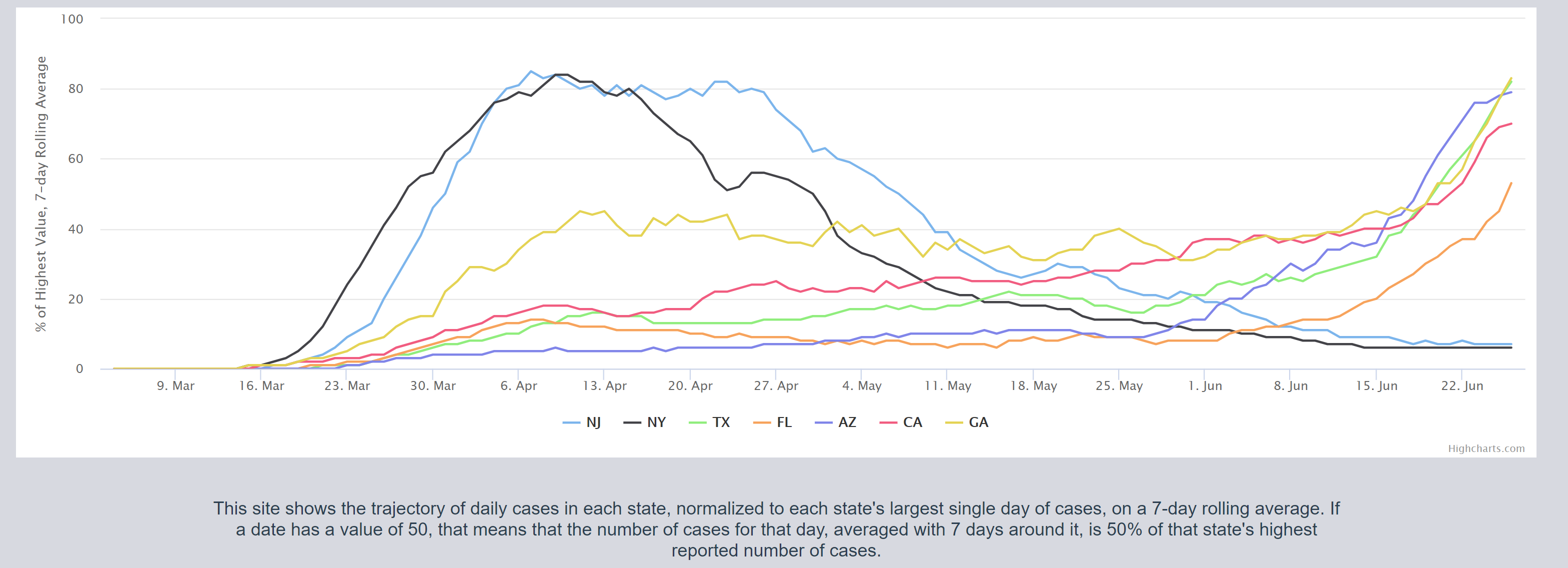
https://covidly.com/graph?country=United States&state=New York#new
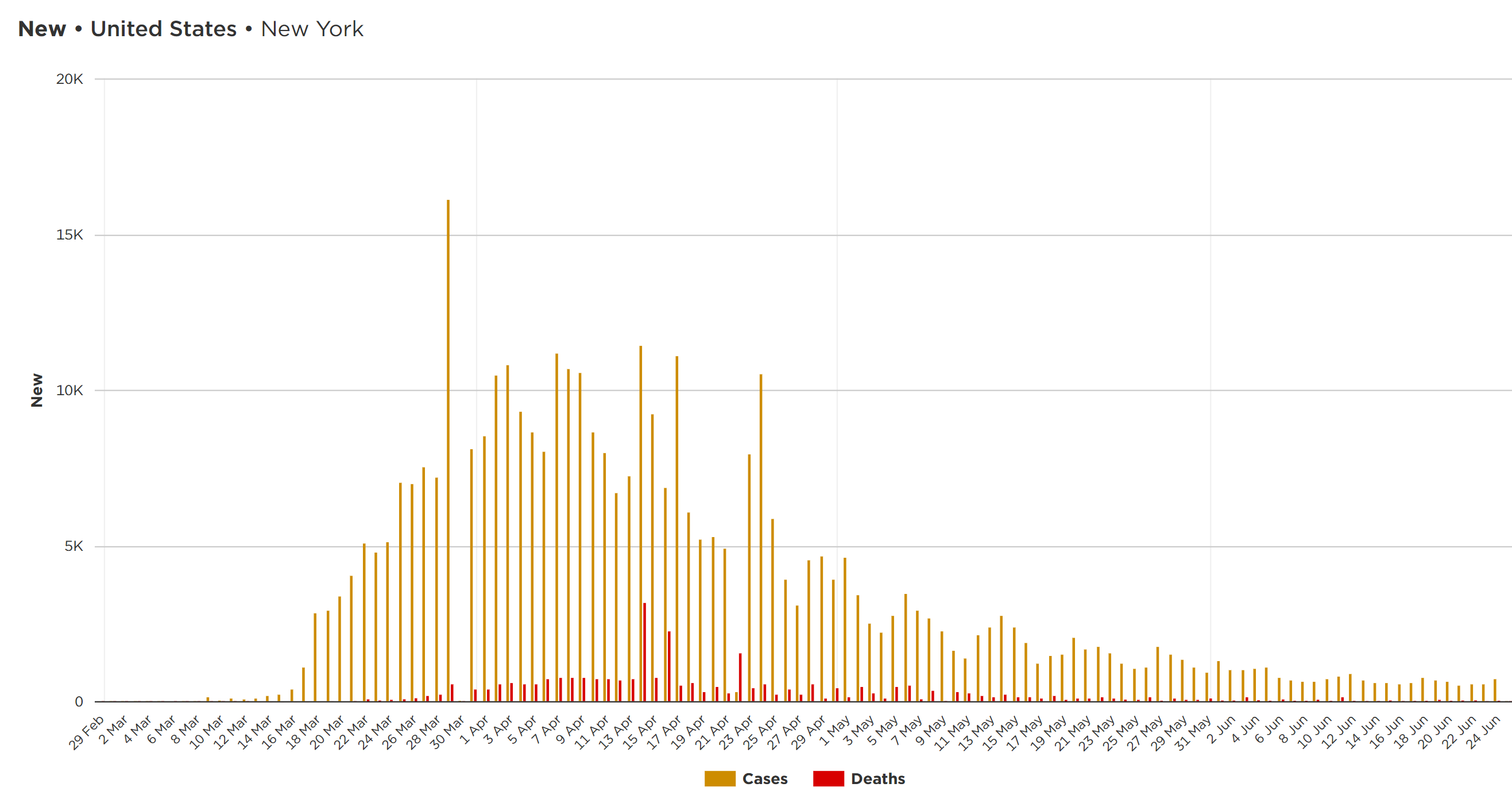
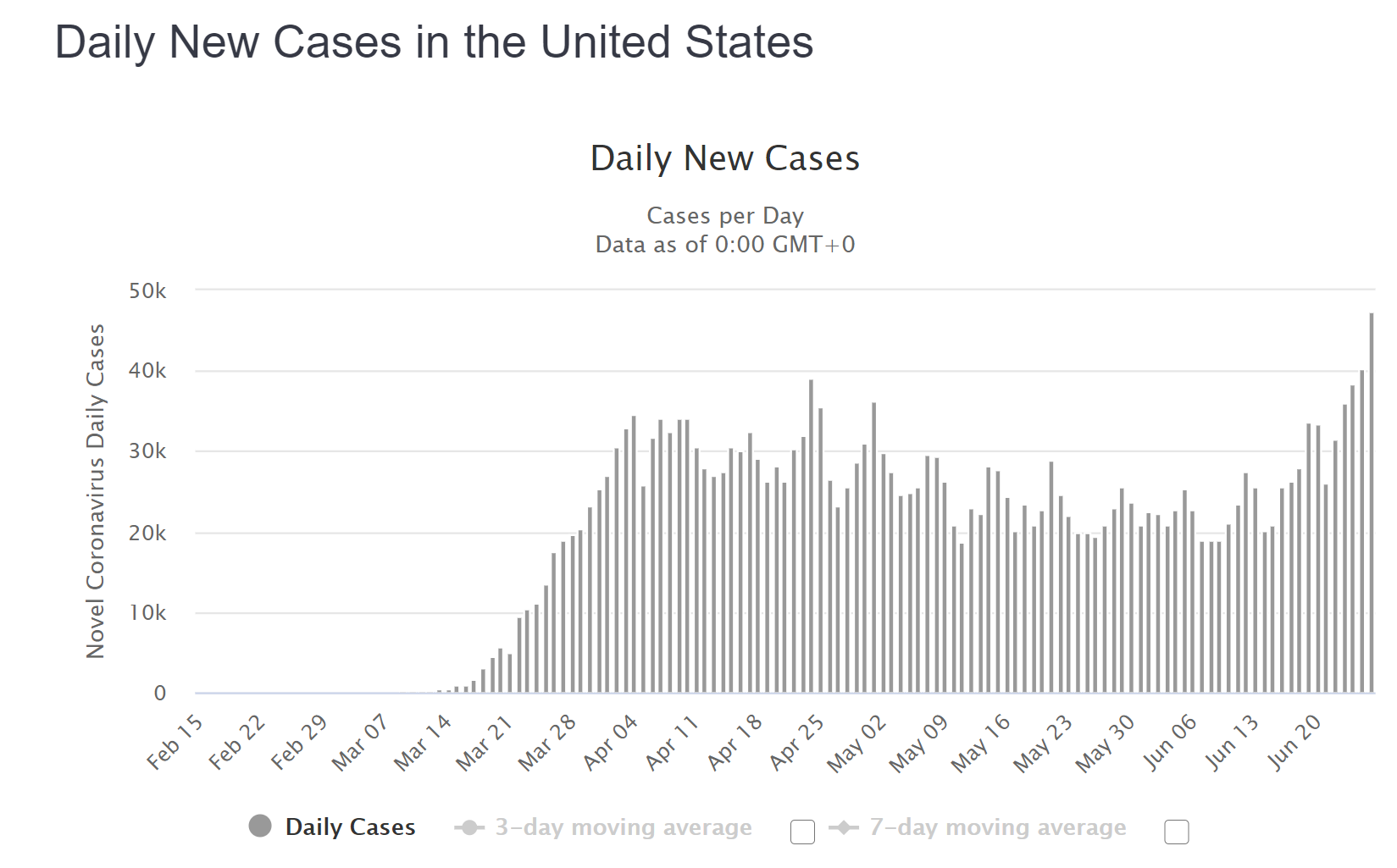
Updating from Saturday's post. Anyone expecting significant increases in deaths in any of these 5 states (TX/FL/AZ/CA/GA) before about now (except maybe AZ; see below) just hasn't been paying attention to previous trajectories/timelines. The increases in cases in May and early June in these states were fairly small, except for AZ, which started climbing significantly in early June, which is likely why we're starting to see deaths climb there the past few days (see graphic for AZ below and FL to see the difference, as FL hasn't really started to rise much yet). I like this graphic more than the simple 7-day moving average, as it normalizes the 7-day average vs the greatest peak in cases on a percentage basis, making state-to-state comparisons on a single graph easier.
The significant increases started about mid-June for TX/FL/CA/GA and given a general 1-2 week lag in seeing hospitalizations rise (which we're seeing) and a general 2-4 weeks lag in seeing deaths increase, so we should start to see deaths increase this week and especially next week. But as I've said multiple times, given more younger people infected, more mild cases detected (with a lot of testing vs. little to no testing in the NY/NJ case, early on), and improved medical procedures/treatments, I would expect the rise in deaths to be somewhat muted vs. what we saw in NY/NJ. If that occurs, that's great for humans, but it makes it hard for scientists to ascribe root causes to a change like that vs. what we saw in the first wave.

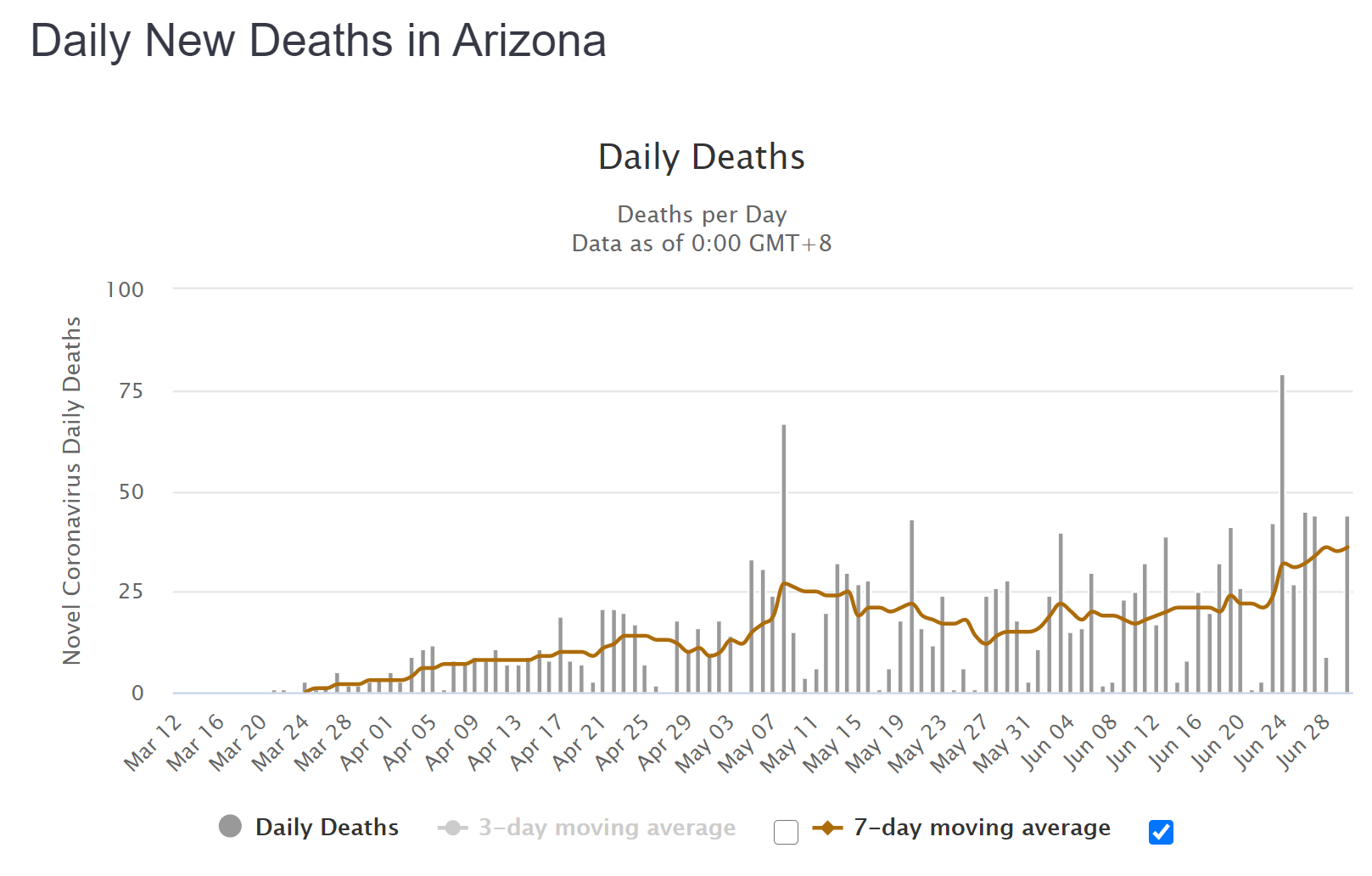
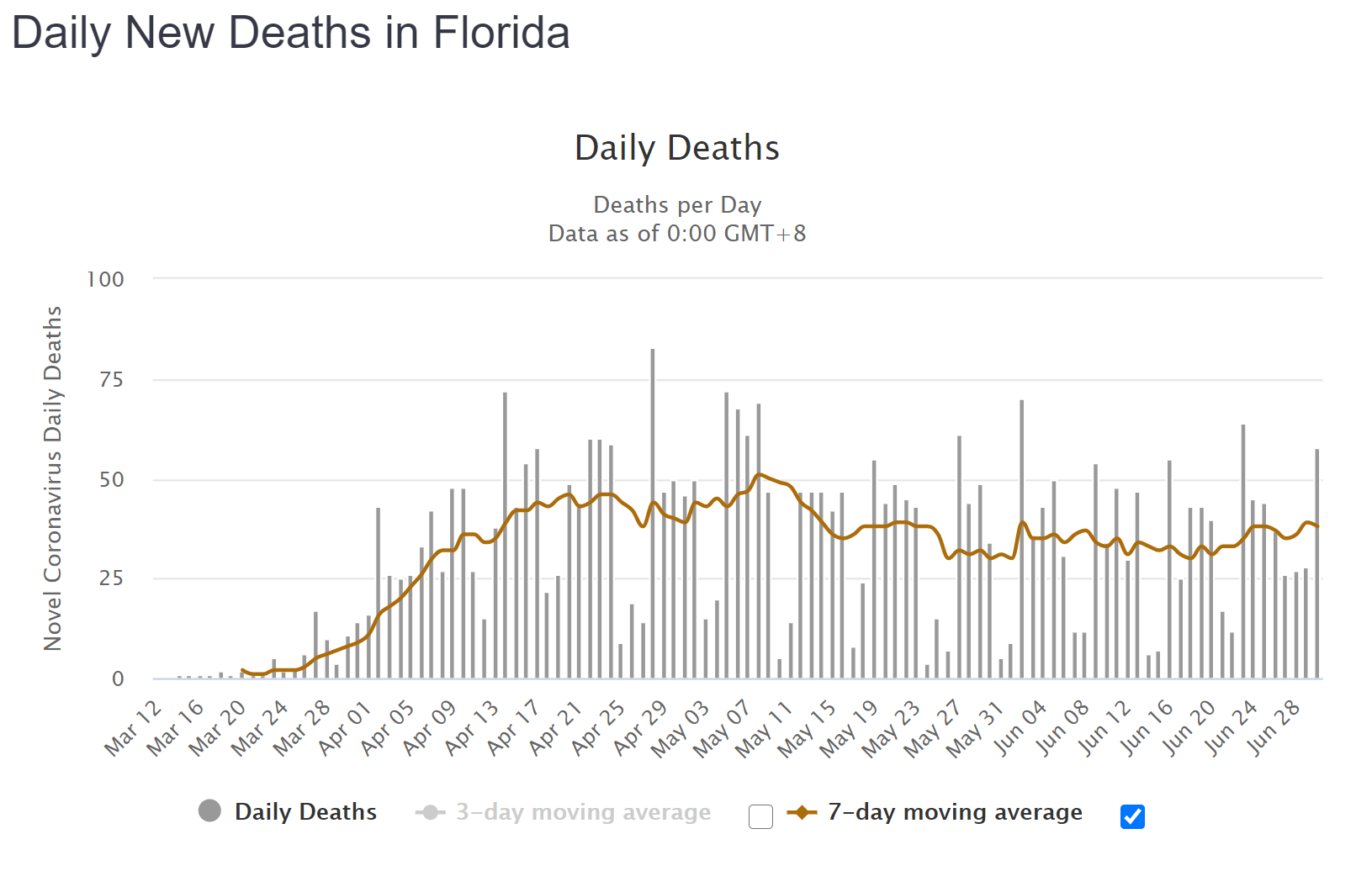
Last edited:
The goal is to avoid overrunning our ICUs. Flatten the curve has the same area under the curve as without measures. The goal was never avoid casualties as that would require destroying the whole world economy. Without a vaccine or treatment to avoid deaths, we have to accept this for what it is as long as we do not overrun hospitals.
Hopefully we have learned enough to avoid the death rates seen in NY/NJ through earlier and better treatment.
Completely disagree, as would South Korea, Taiwan, Japan, New Zealand, Australia, Thailand and even China. All of them either flattened the curve or simply prevented the curve by aggressive interventions (especially masks in most of those countries) and they've maintained very low transmission/death rates, mostly without lockdowns and are banking on having a cure/vaccine sometime soon, so they will hopefully avoid the 400-800 deaths per 1MM being seen in much of the world, including the US (all of them are <10 deaths/1MM) - and assuming they do that, their delay of cases/deaths will end up with them not having anywhere near the same area under the curve. The "destroying the economy" mantra has always been a false choice - we simply didn't pursue the early aggressive intervention plans these other countries did and we've paid for it. Flatten the curve to prevent hospital overload became the goal when it was obvious we didn't do much to try to prevent the curve in the first place.
To be fair, they only added it a few weeks ago, iirc...I can't believe I didn't realize worldometer had the 7 day moving average option.
Completely disagree, as would South Korea, Taiwan, Japan, New Zealand, Australia, Thailand and even China. All of them either flattened the curve or simply prevented the curve by aggressive interventions (especially masks in most of those countries) and they've maintained very low transmission/death rates, mostly without lockdowns and are banking on having a cure/vaccine sometime soon, so they will hopefully avoid the 400-800 deaths per 1MM being seen in much of the world, including the US (all of them are <10 deaths/1MM) - and assuming they do that, their delay of cases/deaths will end up with them not having anywhere near the same area under the curve. The "destroying the economy" mantra has always been a false choice - we simply didn't pursue the early aggressive intervention plans these other countries did and we've paid for it. Flatten the curve to prevent hospital overload became the goal when it was obvious we didn't do much to try to prevent the curve in the first place.
"Even China"
[roll]
This thread becomes more comical each day.
When the Stress Factory reopens you should try amateur night. :Laughing
This thread has been locked and a new thread opened to continue the discussion. Follow it here:
COVID-19 Pandemic: Transmissions, Deaths, Treatments, Vaccines, Interventions and More...
COVID-19 Pandemic: Transmissions, Deaths, Treatments, Vaccines, Interventions and More...
- Status
- Not open for further replies.
Similar threads
- Replies
- 93
- Views
- 3K
- Replies
- 34
- Views
- 2K
- Replies
- 488
- Views
- 24K
- Replies
- 98
- Views
- 3K
ADVERTISEMENT
ADVERTISEMENT